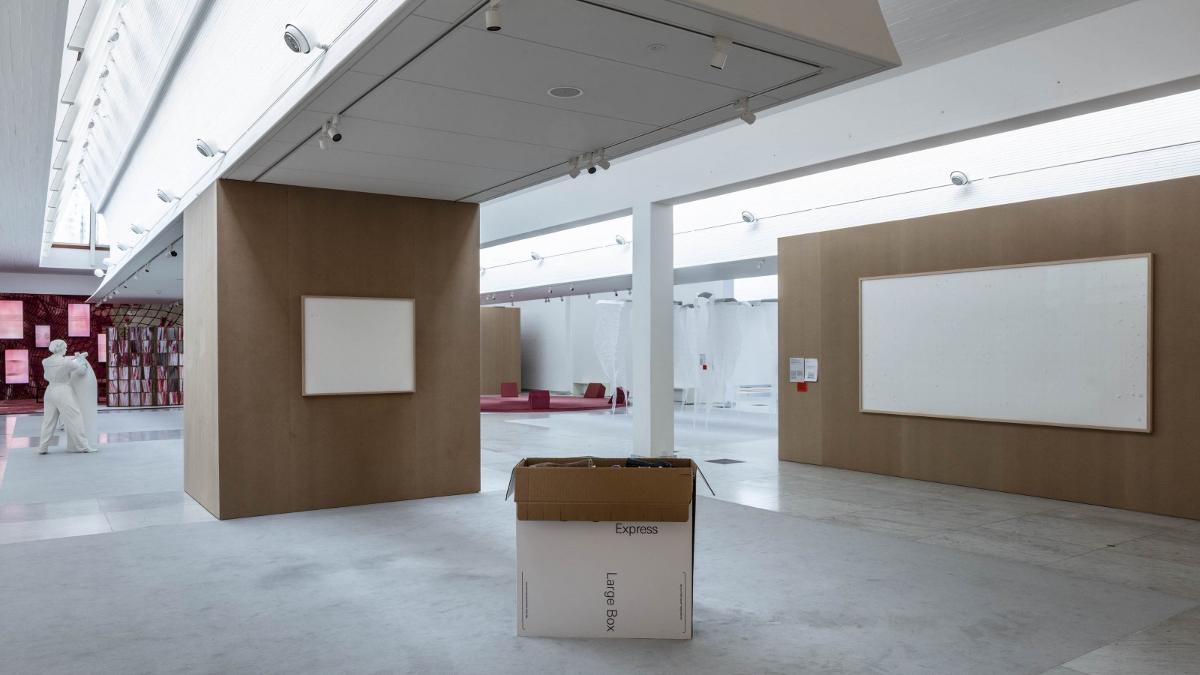
Installation view of Jens Haaning's conceptual work, 'Take the Money and Run,' at the Kunsten Museum of Modern Art in Aalborg.
A court in Copenhagen has ruled that Danish artist Jens Hanning must repay the Kunsten Museum of Modern Art in Aalborg, Denmark $71,000 for delivering two empty frames in 2021 rather than updating commissioned artworks as agreed in a contract. The artist had argued that the breach of contract was a conceptual work he called Take the Money and Run.
Hanning is far from the first artist to pull conceptual fast-ones like this. In 1951, Robert Rauschenberg created five works, each with a different number of panels, but united in the fact that they were all canvases painted completely white. Known as his White Paintings, these works were initially considered shocking and characterized as a cheap swindle. But over time, they have secured a place in art history as an important precursor to Minimalism and Conceptualism. The same cannot be said for Haaning, whose practice as a conceptual artist focuses on power and inequality. He may have had a similar idea to Rauschenberg, but was less successful in its execution.
In 2021, the Kunsten Museum of Modern Art in Aalborg, Denmark, loaned Haaning 534,000 Danish krone ($84,000) to create works of art, but more specifically to recreate and update two earlier works, one from 2007 featuring krone notes affixed to the canvas and called, An Average Annual Danish Income, and the other from 2010 featuring an average annual Austrian income (with Euros affixed to the canvas). Instead of updating those works, Haaning sent the museum two entirely different works, by surprise. Entitled, Take the Money and Run, these works are framed empty canvases that are part of a broader performance piece. According to the artist, the piece is a commentary on low wages, and his breach of contract was, he claims, part of the work.
“I saw, from my artistic point of view, that I could create a much better piece for them than what they could imagine," he told CNN. "I don’t see that I have stolen money…. I have created an art piece, which is maybe ten or 100 times better than what we had planned. What is the problem?”
The Kunsten Museum did not see it his way and sued the artist in court to get their money back. And after a long legal battle, this past Monday, the court ruled in the Museum’s favor, ordering Haaning to refund the museum its money. The court did allow it to be less than the original payment, 492,549 kroner ($71,000), which incorporates the sum that had been originally given, minus the artist’s fee and the cost of mounting.
The artist, who told Danish news outlet dr.dk that he had no plans to appeal, said that although this situation has proven to be good for his work, he does not know what to do next. Haaning’s issue is that the entire point of his artwork was that he has taken the museum’s money and breached their contract. He argues that it was a conceptual trick, and that he was protesting against the artist’s fee he was offered, which he claimed was not sufficient. Ironically, he received that money back.
The museum took issue with the taking of their money for a conceptual gain. They used money from their reserves to commission the works, and have said many times in the press that they are not a museum with funds to accommodate such an artistic move.
These empty canvases are like Rauschenberg’s White Paintings, or Yves Klein’s exhibit of an empty room, or even Maurizio Cattelan’s banana taped to a wall. In all these works, artists have grappled with, poked fun at, or questioned the value we attribute to art. So why is Haaning the only artist to have been completely shut down for his attempt? Perhaps because he was the only one brave enough, or the only one stupid enough to use another institution’s funds for his conceptual gain.
























